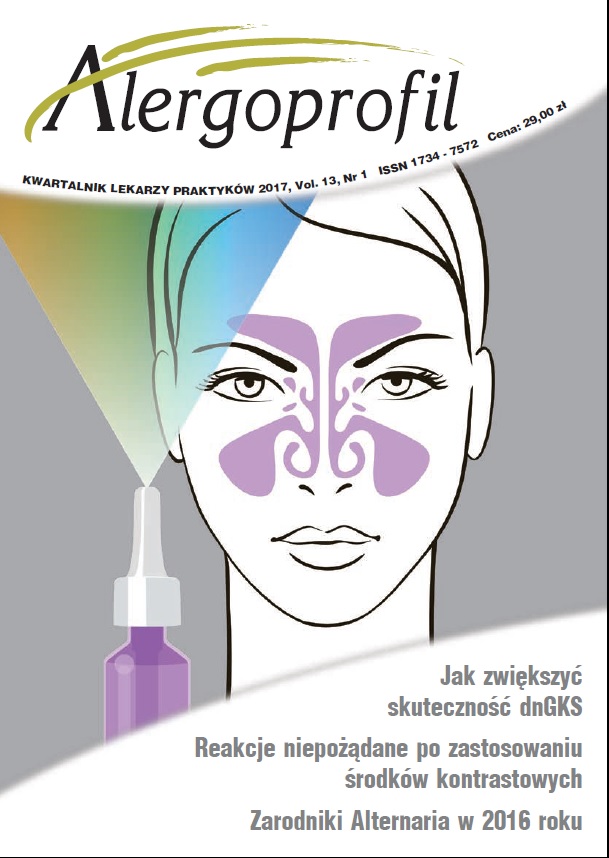How to increase efficacy of intranasal glucocorticosteroids?
Main Article Content
Abstract
Intranasal glucocorticosteroids (inGKS) are among most commonly used intranasal drugs. According to current state of knowledge topical glucocorticosteroids are used in the following upper airway diseases with different inflammatory mechanisms: allergic rhinitis, non-allergic rhinitis, acute and chronic rhinosinusitis, chronic rhinosinusitis with and without nasal polyps. InGKS are used both in prevention (in patients without nasal blockage) and in cases of severe symptoms, nasal blockage among them. Limited penetration of inGKS in nasal cavities may be one of the causes of reduced therapeutic efficacy. This publication presents proposals leading to improvement of action.
Downloads
Article Details
Copyright: © Medical Education sp. z o.o. This is an Open Access article distributed under the terms of the Attribution-NonCommercial 4.0 International (CC BY-NC 4.0). License (https://creativecommons.org/licenses/by-nc/4.0/), allowing third parties to copy and redistribute the material in any medium or format and to remix, transform, and build upon the material, provided the original work is properly cited and states its license.
Address reprint requests to: Medical Education, Marcin Kuźma (marcin.kuzma@mededu.pl)
References
2. Sastre J., Mosges R.: Local and Systemic Safety of Intranasal Corticosteroids. J. Investig. Allergol. Clin. Immunol. 2012, 22(1): 1-12.
3. Rapiejko P., Jurkiewicz D.: Donosowe glikokortykosteroidy w leczeniu nieżytów nosa. Terapia 2014, 22(10): 27-35.
4. Samoliński B., Nowicka A., Wojas O. et al.: Intranasal glucocorticosteroids – not only in allergic rhinitis. Otolaryngol. Pol. 2014, 68(2): 51-64.
5. Arcimowicz M., Buczyłko K., Duda R. et al.: Polskie Standardy Leczenia Nieżytów Nosa (PoSLeNN). Alergol. Pol. 2013: S1.
6. Brozek J.L., Bousquet J., Baena‑Cagnani C.E. et al.: Allergic Rhinitis and its Impact on Asthma (ARIA) guidelines: 2010 Revision. J. Allergy Clin. Immunol. 2010, 126(3): 466-476.
7. Fokkens W.J., Lund V.J., Mullol J. et al.; EPOS 2012: European position paper on rhinosinusitis and nasal polyps 2012. A summary for otorhinolaryngologists. Rhinology 2012, 50(1): 1-12.
8. Roberts G., Xatzipsalti M., Borrego L.M. et al.: Paediatric rhinitis: position paper of the European Academy of Allergy and Clinical Immunology. Allergy 2013, 68: 1102-1116.
9. Rapiejko P.: Alergiczny nieżyt nosa. W: Pawliczak R. (red.): Alergologia Kompendium. Termedia, Poznań 2013: 119-134.
10. Rapiejko P., Wojdas A., Ratajczak J. et al.: Technika podawania leków donosowo. Pol. Merk. Lek. 2005, 19(111): 400-402.
11. Rapiejko P., Jurkiewicz D.: Przewlekły alergiczny nieżyt nosa. Alergoprofil 2014, 10(3): 3-11.
12. Jurkiewicz D., Rapiejko P.: Choroby nosa i zatok przynosowych. W: Niemczyk K., Jurkiewicz D., Składzień J. et al.: Otorynolaryngologia kliniczna. Tom 2. Medipage, Warszawa 2015.
13. Bousquet J., Schunemann H.J., Fonseca J. et al.: MACVIA-ARIA Sentinel NetworK for allergic rhinitis (MASK-rhinitis): The new generation guideline implementation. Allergy 2015, 70(11): 1372-1392.
14. Rapiejko P., Stankiewicz W., Szczygielski K., Jurkiewicz D.: Threshold pollen count necessary to evoke allergic symptoms. Otolaryngol. Pol. 2007, 61(4): 591-594.
15. Rapiejko P.: Elektroniczne kwestionariusze monitorujące objawy ułatwią diagnostykę i leczenie alergicznego nieżytu nosa. Alergoprofil 2016, 12(4): 153-159.
16. Hryniewicz W., Albrecht P., Radzikowski A. (red.): Rekomendacje postępowania w pozaszpitalnych zakażeniach układu oddechowego. Narodowy Instytut Leków, Warszawa 2016.
17. Rapiejko P., Jurkiewicz D.: Zapalenie zatok przynosowych. Terapia 2011, 11-12(265): 31-40.
18. Rapiejko P., Sosnowski T.R., Sova J., Jurkiewicz D.: Deposition of intranasal glucocorticoids – preliminary study. Otolaryngol. Pol. 2015, 69(6): 30-38.
19. Rapiejko P., Jurkiewicz D., Sosnowski T.R.: Zależność efektu działania donosowych glikokortykosteroidów od depozycji leku w jamach nosa. Alergoprofil 2016, 12(1): 5-10.
20. Harvey R., Hannan S.A., Badia L., Scadding G.: Nasal saline irrigation for the symptoms of chronic rhinosinusitis (Review). Cochrane Database Syst. Rev. 2007, (3): CD006394. DOI: 10.1002/14651858.
21. Talbot A., Herr T., Parsons D.: Mucociliary clearance and buffered hypertonic saline solution. Laryngoscope 1997, 107(4): 500-503.
22. Rapiejko P., Jurkiewicz D.: Wpływ stosowania roztworu izotonicznego wody morskiej (Marimer) na objawy chorobowe oraz stan błony śluzowej nosa u chorych z uczuleniem na alergeny pyłku roślin. Alergoprofil 2007, 3(4): 29-35.
23. Schäfer T., Schnoor M., Wagenmann M. et al.: Therapeutic Index (TIX) for intranasal corticosteroids in the treatment of allergic rhinitis. Rhinology 2011, 49: 272-280

